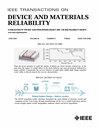面向先进技术的数字电路零温延点可靠性与优化仿真研究
IF 2.5
3区 工程技术
Q2 ENGINEERING, ELECTRICAL & ELECTRONIC
IEEE Transactions on Device and Materials Reliability
Pub Date : 2023-12-19
DOI:10.1109/TDMR.2023.3344639
引用次数: 0
摘要
热挑战对先进技术的影响越来越大,温度变化大的工作环境也是对系统性能和可靠性的重要威胁之一。为了提高数字电路的抗温能力,本文确定了使延迟不受温度变化影响的电源电压(VDD),它不同于模拟应用中使用的零温度系数(ZTC)点,被定义为零温度延迟(ZTD)点。通过仿真研究了数字电路中 ZTD 点的相关性和最佳选择。对包括标准单元类型和电路操作在内的影响因素进行了相应的研究。此外,还讨论了不同延迟指标对 ZTD 点的影响,这也是在标准单元级选择 ZTD 点的基础。研究了五个 PVT 角引起的 ZTD 点变化以及在这些 PVT 角下的 ZTD 点选择。以三种延迟链和基准电路为例,进一步研究了电路关键路径上的 ZTD 点。仿真结果证实,在数字电路设计过程中利用 ZTD 电压可以提供更好的耐温解决方案,这对温度抗扰性数字应用非常有意义。本文章由计算机程序翻译,如有差异,请以英文原文为准。
Reliability and Optimization Simulation Study of Zero-Temperature-Delay Point in Digital Circuits for Advanced Technology
Thermal challenges are increasingly significant for advanced technology, and the operating environment with large temperature variation also acts as one of the crucial threats to the system’s performance and reliability. To improve the temperature immunity of digital circuits, in this work, the supply voltage (VDD) making the delay immune to temperature variation is identified, which differs from the zero-temperature-coefficient (ZTC) point used in analog applications and is defined as the zero-temperature-delay (ZTD) point. The dependencies and optimal selection of ZTD point in digital circuits are studied by simulation. The influence factors including standard cell types and circuit operations have been investigated accordingly. Moreover, the exploration of ZTD point with different delay metrics is discussed, which is the basis of the selection of ZTD point at standard cell level. The ZTD point changes due to the five PVT corners and the selection of the ZTD point under these PVT corners are studied. Taking three kinds of delay chains and benchmark circuits as an example, the ZTD point in the critical path of the circuit is further investigated. The simulation results confirm that utilizing the ZTD voltage during the design of digital circuits can provide a better temperature-resistant solution, which makes sense for temperature immunity digital applications.
求助全文
通过发布文献求助,成功后即可免费获取论文全文。
去求助
来源期刊

IEEE Transactions on Device and Materials Reliability
工程技术-工程:电子与电气
CiteScore
4.80
自引率
5.00%
发文量
71
审稿时长
6-12 weeks
期刊介绍:
The scope of the publication includes, but is not limited to Reliability of: Devices, Materials, Processes, Interfaces, Integrated Microsystems (including MEMS & Sensors), Transistors, Technology (CMOS, BiCMOS, etc.), Integrated Circuits (IC, SSI, MSI, LSI, ULSI, ELSI, etc.), Thin Film Transistor Applications. The measurement and understanding of the reliability of such entities at each phase, from the concept stage through research and development and into manufacturing scale-up, provides the overall database on the reliability of the devices, materials, processes, package and other necessities for the successful introduction of a product to market. This reliability database is the foundation for a quality product, which meets customer expectation. A product so developed has high reliability. High quality will be achieved because product weaknesses will have been found (root cause analysis) and designed out of the final product. This process of ever increasing reliability and quality will result in a superior product. In the end, reliability and quality are not one thing; but in a sense everything, which can be or has to be done to guarantee that the product successfully performs in the field under customer conditions. Our goal is to capture these advances. An additional objective is to focus cross fertilized communication in the state of the art of reliability of electronic materials and devices and provide fundamental understanding of basic phenomena that affect reliability. In addition, the publication is a forum for interdisciplinary studies on reliability. An overall goal is to provide leading edge/state of the art information, which is critically relevant to the creation of reliable products.
 求助内容:
求助内容: 应助结果提醒方式:
应助结果提醒方式:


